Your cart is currently empty!
Where Is Clay Found? – How to Get Your Hands on Clay Soil
Published:
Last Updated:
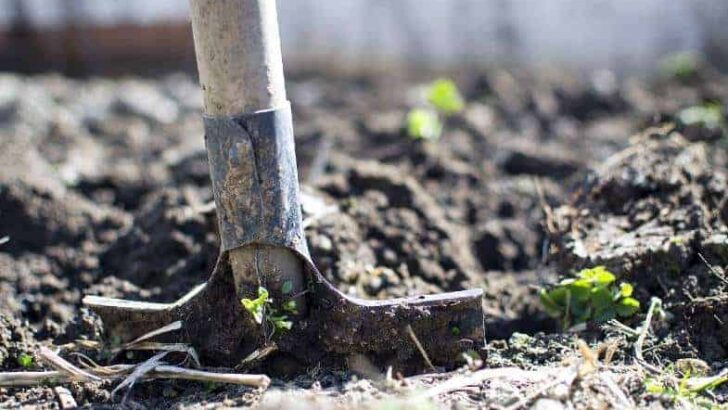
Affiliate Disclaimer
As an affiliate, we may earn a commission from qualifying purchases. We get commissions for purchases made through links on this website from Amazon and other third parties.
Clay is dug up from the ground and processed so it can be used to make pottery. Often it is manufacturers who mine the clay and transport it to a processing plant. Sometimes it is individual potters who want to be self-sufficient. But this raises the question, where is clay found?
Good clay for pottery occurs naturally from the earth in regions where rivers and streams were once present, made up of years of sedimented mineral and organic matter. Even though clay is fine and does not usually occur as a singular mass (especially if you have not seen the lump rock form of clay), it is a form of sedimentary rock still.
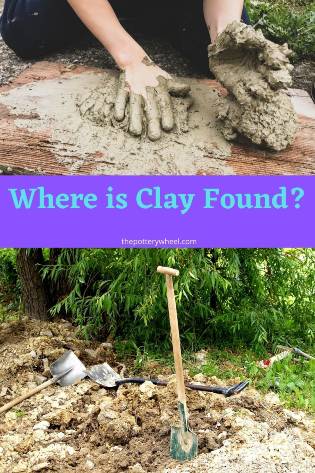
Where is Clay Found?
Before going deeper into the exact nature of how to get your hands on clay soil, we need to understand what the different types of clay are.
Different Types of Clay
Like I mentioned in the opening parts of this piece, you can probably find some clay in your backyard right now.
That, maybe, led me to believe that clay can be found anywhere and everywhere. It took some time in the pottery world to see how wrong that was. In fact, there are specific kinds of clay that you can – and should only – use for pottery. I touch more on that in the later aspects of this piece too.
For now, let’s see the two main different types of play, what separates them from one another, and what they mean for you.
Primary Clay (Residual Clay)
As the name implies, the primary clays are those that are found at the point of creation.
The primary clay feels like gold to the potter who discovers it and I would not blame them if they do not share the source of their deposits.
So, what does it mean?
When clay is formed from sedimentation, erosion of other rock particles, and decomposition of mineral and organic matter, it might move or stay put. When it is not moved from one location to the other, it is referred to as primary clay.
The biggest benefit to primary clay is in the absence of mobility. That means that the clay particles had not picked up any impurities over time. They, thus, retain most of the clay properties with little to no interference from other materials/ minerals which would have added up to them if they were mobile.
The chemical properties of primary clay include:
- Silica
- Alumina and
- Water (chemically bonded)
Also called residual clay, the purest form of clay is usually white.
Some Properties of Primary Clay
Here are some of the physicochemical properties of the primary clay:
- Occurs as a naturally white clay
- Contains no iron content
- Doesn’t move from where it is formed
- Characterized by low plasticity
- Regarded as the purest form of the clay
- Maturity temperature is between 2700 – 3300 degrees Fahrenheit.
Secondary Clay (Sedimentary Clay)
Knowing what primary clay is, it is easier for you to guess what secondary clay might mean for us.
In simple terms, this is a form of clay that has moved from where it was formed to a new site.
But then, does that mean farming primary clay from the site and taking it to your studio makes it secondary clay? No, not at all.
The movement of secondary clay to a new site does not have direct human influence in it. This movement is facilitated by water bodies (streams and rivers) and ice (glaciers), depending on the prevalent condition of where the primary clay was formed.
In the process of this movement, the primary clay picks up additional minerals and elements on the way. This is possible since water carries a lot of materials, not just clay. When the water reaches its destination and deposits the clay, it would have become a less pure version of what it started with.
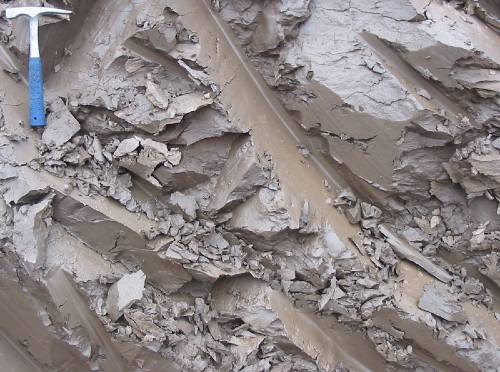
Some Properties of Secondary Clay
Some of the things you will observe on the surface of secondary clay – as well as under the hood during chemical tests – include:
- The concentration of iron. The more iron is present in the clay sample, the darker it is.
- Colors before and after firing could include brown, tan, cream, or other ruddy colors.
- Secondary clay is the best for making stoneware, fire clay, and surface clay.
- Depending on the exact kind and properties of secondary clay, they mature across the 2000 – 2400 degrees Fahrenheit range.
The Different Kinds of Clay Deposits
Knowing the types of clay is just one piece of the puzzle.
Now, you also need to know what kinds of deposits to look for when hunting for some clay. It needs no telling that the kind of clay that you will expect to find in deposits are secondary clay. After all, they are the ones that have been transported from their primary place of formation to the new location.
For that, there are three main kinds of deposits (besides primary clay deposits, of course) to consider here:
Alluvial Deposits
An alluvial deposit refers to clay that has been transported and left behind by rivers and streams.
The alluvial deposits that you find today did not happen anytime in the near past. It would have taken hundreds to millions of years for these depositions to happen such that the clay is present in appreciable quantities today.
Likewise, that tells you another thing:
Alluvial deposits are not always in a river or near a river. Since rivers tend to shift/ dry up with time, you only need to find places where rivers used to be or pass through. For most people, it is just easier to look for where a river currently is and test their lucks there.
That said, you should know that the alluvial deposits won’t give you all their clay on a platter of gold. More often than not, they want you to work for it too.
When digging through them, it is not uncommon to be faced with layers of silt, sand, gravel, and loam before you start finding clay.
The kind of materials that the clay has picked up while in transit will also impact the quality. On average, though, you will find good clay here.
Marine/ Lacustrine Deposits
Take a look at the bright colors of the Grand Canyon. Get familiar with that color before you embark on your quest for clay in a marine deposit.
Like the above, they are also deposited by water bodies. Unlike the above, they are a result of the work of seas and lakes. They will, thus, be of a higher quantity than those deposited by rivers.
Another similarity between alluvial and lacustrine deposits is how there are different layers of different materials. Don’t expect to get all clay there but with a committed digging exercise, you will find good clay.
That said, you should also not only look for where seas and lakes currently exist. I know that searching near where these water bodies used to exist or pass through does not sound easy. However, find one and you will have an endless supply of good clay for a long time to come.
Glacial Clays
The mistake that most people make is thinking that they cannot find glacial clay deposits in their area. That would sound logical if you are not in a polar climate kind of location. If the science of climate change is anything to go by, though, you know that an ice age from years ago could have had glaciers in your area.
So, how about you go looking?
The best thing about glacial clays is that they don’t get buried under a lot of layers. Sometimes, you find them on the topsoil itself or just buried under this soil. This is one feature that they share with primary clay deposits.
Some of the basic tell-tale signs of glacial clays on normal-looking land include, but is not limited to:
- Sticky and slippery roadbeds
- Cracked, dry earth texture
- Surface/ top-soil clay
Do All Clays Work The Same?
Classing clays under primary and secondary headings alone is not enough to show the differences in their application.
You can have different kinds of secondary clay that are not all good for the same purposes.
For example, some clay can be used for making great bricks but fail when it comes to creating pots in the studio. In the same way, some clays can also look like the best thing you can work with, only to turn on you in the middle of the throwing process and prove difficult.
There’s a small test I recommend for trying out whether or not you should bother with a body of clay while out in the field. This saves you the digging time and resources to transport the clay back to your studio only to see that it isn’t worth it.
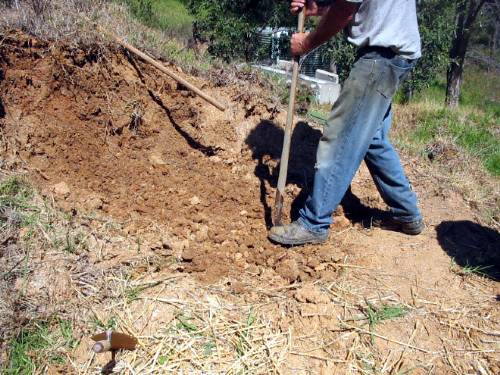
The Test
For Dry Lumps of Clay:
- Scrape the surface of the clay deposit with a knife, spatula, or other similar objects.
- The first tell-tale sign here is the fine particles falling off. If they do not, it is not clay. If they do, it is clay.
- Take some of the fine particles and wet them with some water. Clay will dissolve, but sand/ other earthen materials won’t.
- From the lump, create a small ball and feel with your fingers.
- Stickiness means the presence of clay in the soil sample. Non-stickiness means you should not bother with it at all.
Now, this test confirms that there is some clay in the soil sample. It doesn’t tell you how much clay is in the soil sample in the first place.
Depending on the level of clay in the sample, you might have to do a lot of initial processing work to separate the clay itself from other impurities in the sample.
For Wet Lumps of Clay:
- Pick up a small lump of the wet clay, rolling it into a ball between your fingers
- With both palms, roll the ball into a sausage-like shape
- Bend the sausage slightly around your finger
- The above steps confirm that you are dealing with clay. The below pointers tell you if you should bother with it.
- If the clay cracks, don’t bother collecting and working with it.
- If the clay bends smoothly, you’re in luck. Get as much of that clay and take it back to your studio.
What to Do When Finding Clay
Besides all of the information that you have already gotten from this piece, there are a few more pointers that you should keep in mind.
For starters:
- Have patience – if you do not live in an area where clay is abundant, you will need to exercise patience in finding your deposit. It gets frustrating when you have done everything seemingly right but the clay is not coming to you. Keep at it more and you will discover a deposit soon.
- Prepare for the exercise – you have seen the different places where you can find clay as defined here. If you are serious about how to get your hands on clay soil, you should be ready for some climbing, hiking, getting into rivers, etc. Dress for the occasion, and when possible, go with someone. Pack a lunch bag if need be.
- Never settle for less – the clay tests described in this piece are there for a reason. There is nothing as painful as getting back to the studio, working to an extent then seeing that the clay you thought that you found does not agree with you. If need be, dedicate multiple days to your search for good clay. After all, when you find one good deposit, you are saved months of looking for yet another one.
- Know your locale – before anything else, know if you have a chance of finding clay in your locale at all. Otherwise, you might be stepping out for an exercise in futility. Note that there is clay everywhere there is earth. The issue is, clay is not always present in commercial quantities everywhere, nor is it all good clay.
- Get Help – you don’t have to rely on your instincts and knowledge alone. There are online and offline guides that spell out where clay deposits can be found in the world. One such guide is a geological map of your area. You can also find luck with resources like the British Geological Survey, Southern United States clay deposit database, and other local equivalents.
- Don’t break the law – the fact that you found clay does not mean you can legally obtain the clay. If it is on private property, make sure to discuss and get permission from the landlord before mining their clay. This sounds like such a trivial thing, but remember that you can be charged with trespassing if you are found ‘stealing’ soil on someone else’s property.
Where is Clay Found in the US
The United States is one of those prime locations for clay in the world.
For starters, the continental earth (land part) consists of up to 2.8% clay so it should be found in varying quantities almost everywhere. However, you cannot find clay deposits anywhere.
Fortunately, the US enjoys the largest deposits of different kinds of clay in the world.
Kaolin
Kaolin, which is also known as white clay or china clay, is the best kind of clay for pottery.
The clay belongs to the primary class and gives off the best effect when working with it. Originally discovered in the Gaoling village in China, the original samples have made it to different parts of the world and have been found elsewhere too.
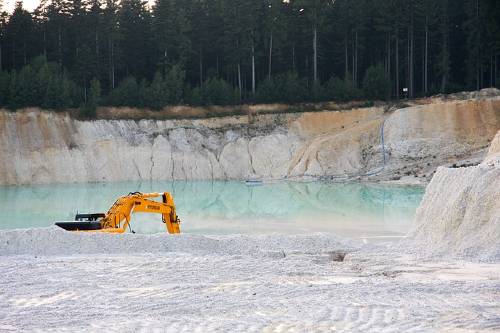
Since the clay was discovered in Asia, you would think that the countries there will have the largest, good-quality deposits. Surprisingly, the largest depots for this clay can be found in South Carolina and Georgia. More than half a billion tonnes of this kaolin have been shipped over the past three decades alone, and the deposit still has more to offer today.
That is not the only place where they can be found in the US, but the places where they are most abundant.
Bentonite
Bentonite is yet another kind of clay, characterized by its extremely small particle sizes. The clay is also highly plastic, making it find good application in a lot of ceramic processes.
It is, thus, good to know that clay can also be found in the US. You cannot just find them in the US, but the country has the largest and purest deposits of clay material in the world also.
Head over to places like South Dakota, Wyoming, and Montana, and you have the clay at your beck and call.
The bentonite you can find in the regions above is referred to as sodium bentonites. For calcium bentonite, head over to Texas, Alabama, Georgia, Mississippi, and Illinois, among other areas.
Even if you do not gain access to the top sites where this clay is mined, you will still find it around.
Other Kinds of Clay in the US
Besides the two above, you can also find:
- Ball clay
- Common clay
- Fuller’s earth and
- Fire clay in the US
They are all present in appreciable quantities.
As a general guideline, the southern US states are blessed with a lot of clay and clay deposits. That does not mean that you cannot get them in the northern states. It only means that you won’t get clay with as much abundance in the north as you would in the south.
Where is Clay Found in Other Regions of the World?
Unfortunately, not all areas in the world have a clearly defined geological map that allows us to understand which areas clay is in abundance, or will be present.
Like I have mentioned somewhere in this piece, there is a high chance that you will find clay in your immediate area. The only question remains whether or not it would be of good quality.
Now that we have that out of the way, top areas in the world with substantial clay deposits include:
- France
- England
- New Zealand
- Germany and
- Czech Republic
These areas represent some of the best kaolin deposits in the world too. Since we have already established that it is the best kind of clay for pottery, the reason why they were chosen first is not farfetched.
Looking elsewhere, you can also find good clay in these specific regions from all over the world.
Final Thoughts
If you ever had to ask yourself, or just wondered “Where is clay found?” ever again, I believe all the information in here should come in handy.
I have also gone the extra step of showing you how to get your hands on clay soil and determine if it is good enough for your needs. Whether as a beginner, intermediate or expert potter, this resource should be all you need to find high-quality clay from anywhere in the world.
Remember to take note of all the different kinds of clay out there. Also, keep in mind the tips to remember when finding clay so that you don’t burn yourself out nor get frustrated by the process.
With that, I leave you with your new adventure to find native clay for your next pottery project.



